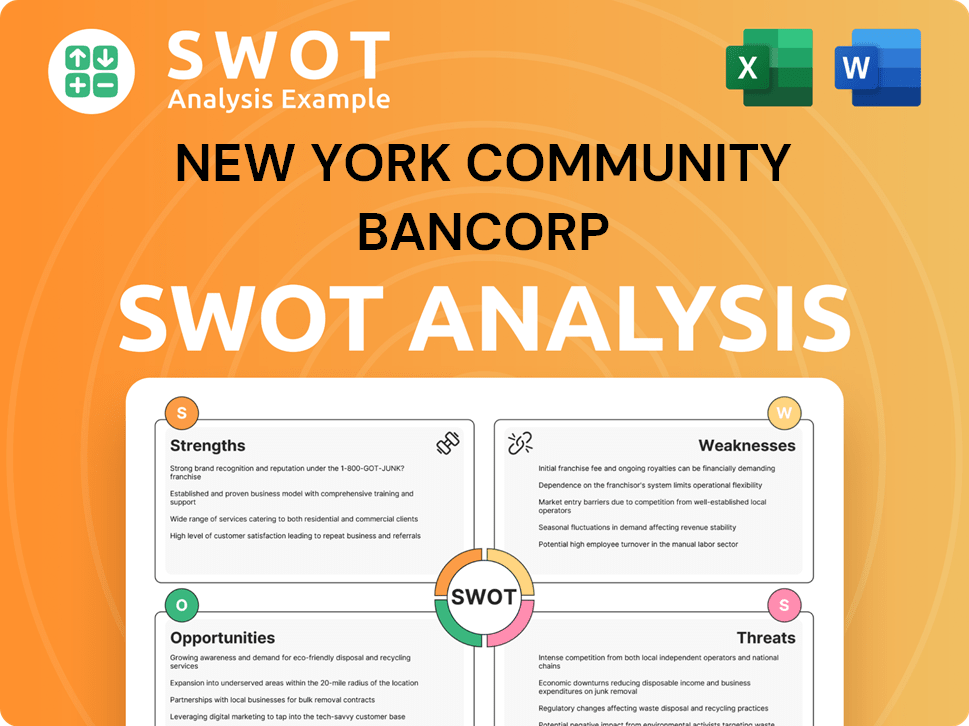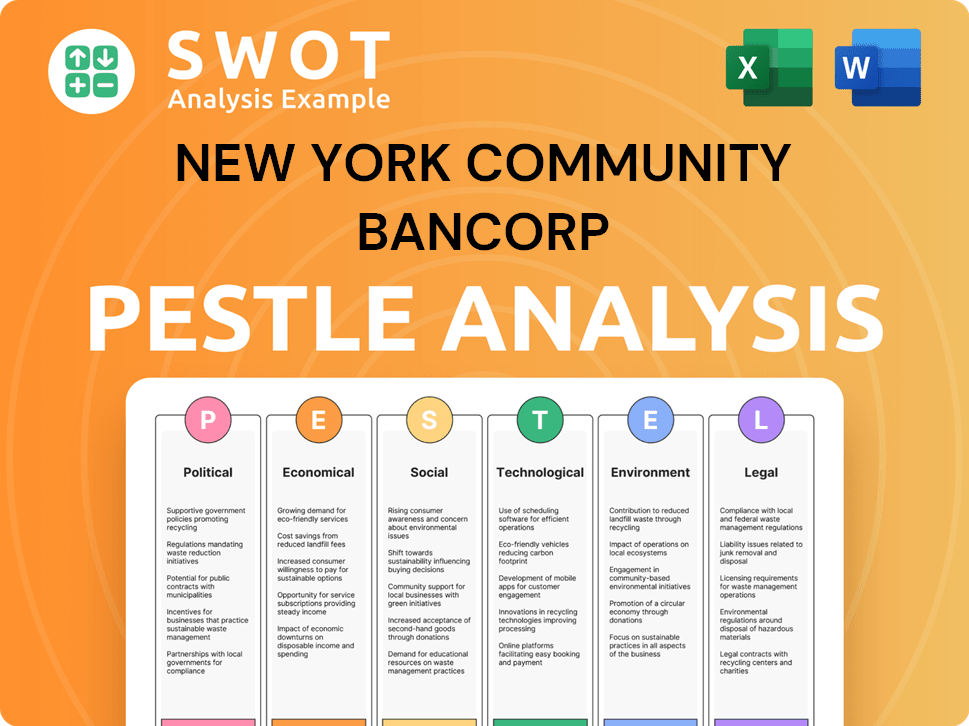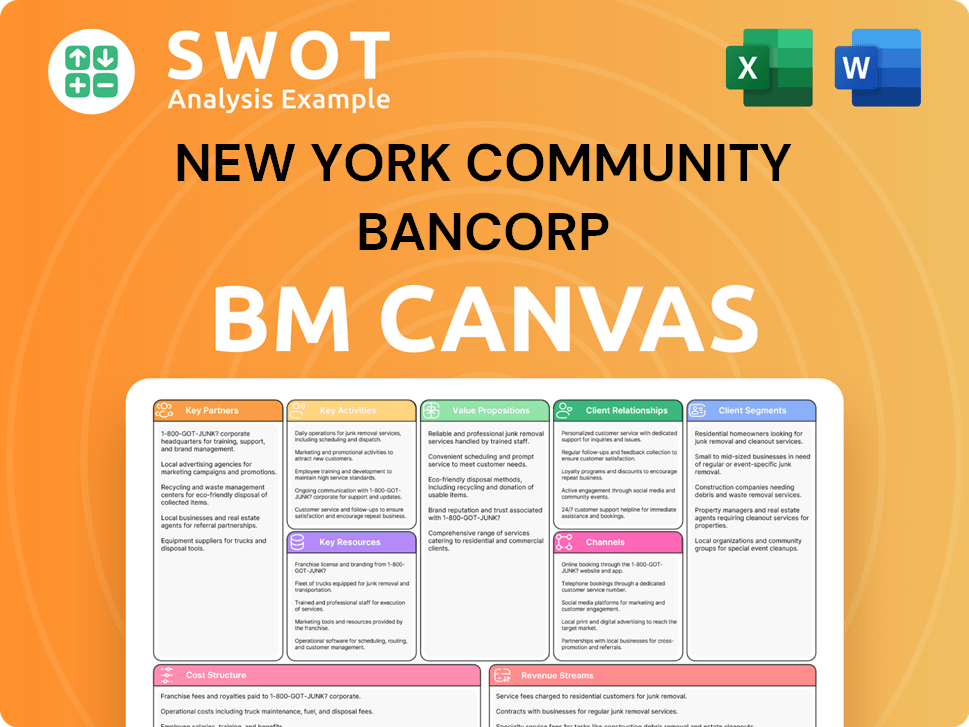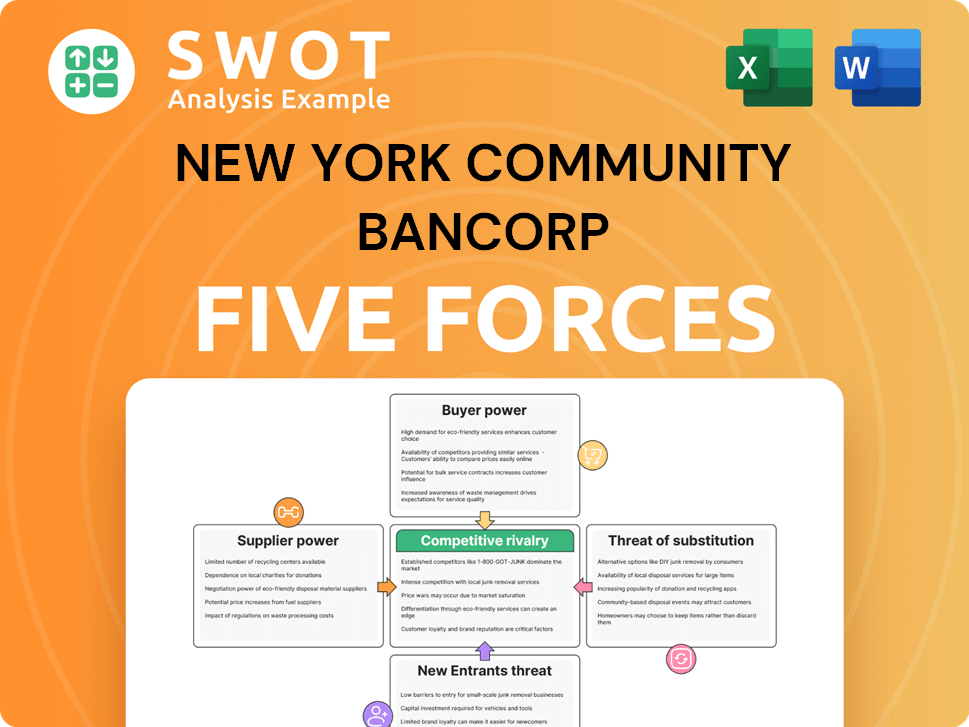New York Community Bancorp Bundle
How has New York Community Bancorp Evolved?
Embark on a journey through the New York Community Bancorp SWOT Analysis, a financial institution whose story is as captivating as the markets it navigates. From its roots as a community savings bank to its present-day status, NYCB's evolution reflects the dynamic shifts in the banking landscape. Discover the key milestones and strategic decisions that have shaped this influential player in the financial world.

The NYCB history is a testament to strategic adaptation and expansion within the financial sector. This community bank has experienced significant growth through acquisitions and mergers, including the pivotal Signature Bank asset purchase and the Flagstar Bank merger. Understanding NYCB's acquisitions and mergers provides valuable insights into its current market position and future prospects. Delving into the brief history of New York Community Bancorp offers a crucial perspective for investors and financial professionals alike.
What is the New York Community Bancorp Founding Story?
The story of New York Community Bancorp (NYCB) begins in the mid-19th century, a time when community banking played a vital role in local economies. The Target Market of New York Community Bancorp has evolved over time, but its roots are firmly planted in serving the financial needs of local communities.
The institution's origins can be traced back to April 14, 1859, with the chartering of Queens County Savings Bank in Flushing, Queens, New York. This marked the start of what would become a significant player in the financial landscape of New York. The primary goal was straightforward: to offer convenient banking services to the residents of Queens, eliminating the need for them to travel to Manhattan for their financial transactions.
The early days of NYCB, then Queens County Savings Bank, were characterized by its focus on serving the local community. The initial funding came from community deposits, a common practice for mutual savings banks of that era. The bank remained focused on Queens until the early 1990s, when it began a significant transformation under the leadership of Joseph R. Ficalora.
Here's a look at the key aspects of NYCB's founding and early years.
- Founding Date: April 14, 1859, as Queens County Savings Bank.
- Initial Purpose: To provide convenient banking services to the residents of Queens.
- Early Focus: Serving the local community through traditional savings bank practices.
- Key Figure: Joseph R. Ficalora, who joined Queens County Savings in 1965 and later led its transformation.
New York Community Bancorp SWOT Analysis
- Complete SWOT Breakdown
- Fully Customizable
- Editable in Excel & Word
- Professional Formatting
- Investor-Ready Format

What Drove the Early Growth of New York Community Bancorp?
The early growth and expansion of New York Community Bancorp (NYCB) marked a significant phase in its history, largely driven by strategic acquisitions and organic growth. Under the leadership of Joseph R. Ficalora, the company transformed from a savings bank to a major financial institution. This period saw a series of mergers and acquisitions that expanded its footprint and asset base considerably, solidifying its position in the market.
In 1993, Queens County Bancorp, Inc. was established as the holding company for Queens County Savings Bank. The company went public through an initial public offering, marking a pivotal moment in its journey. At the time of its conversion to stock form, the institution held approximately $900 million in assets, laying the foundation for future expansion and growth.
The early 2000s were characterized by aggressive expansion through mergers and acquisitions. In 2000, NYCB acquired Haven Bancorp for $196 million and changed its name to better reflect its broader market area. This was followed by the acquisition of Richmond County Financial Corporation in 2001 for $802 million. In 2003, NYCB acquired Roslyn Savings Bank for $1.58 billion, further expanding its presence.
By December 31, 2005, NYCB had grown to $26.3 billion in assets, demonstrating significant growth. Further expansions included the acquisition of Long Island Financial Corporation in 2005, leading to the establishment of New York Commercial Bank. The acquisition of AmTrust Bank in December 2009 expanded its branch network beyond the New York metropolitan area.
By September 30, 2022, prior to the Flagstar merger, NYCB had approximately $88.4 billion in assets, $66.0 billion in loans, and $58.3 billion in deposits, showcasing its strong financial standing. This growth was fueled by organic loan production, particularly in multifamily residential mortgages, and a consistent strategy of successful merger transactions. For more insights, you can explore the Revenue Streams & Business Model of New York Community Bancorp.
New York Community Bancorp PESTLE Analysis
- Covers All 6 PESTLE Categories
- No Research Needed – Save Hours of Work
- Built by Experts, Trusted by Consultants
- Instant Download, Ready to Use
- 100% Editable, Fully Customizable

What are the key Milestones in New York Community Bancorp history?
The brief history of New York Community Bancorp, now operating as Flagstar Financial, Inc., is marked by significant achievements and strategic shifts. From its early days as a community bank to its current status as a regional financial institution, the company has navigated various market conditions and regulatory landscapes.
| Year | Milestone |
|---|---|
| 1993 | NYCB was listed on NASDAQ, starting with approximately $1 billion in assets. |
| 2005 | The bank had grown to $26.3 billion in assets through various acquisitions. |
| December 2022 | Completed the acquisition of Flagstar Bancorp, Inc., creating a regional banking franchise and diversifying its portfolio. |
| March 2023 | Acquired assets from Signature Bank, including $34 billion in deposits and $13 billion in loans, boosting total assets to $123 billion. |
| July 2024 | Announced a one-for-three reverse stock split. |
| October 2024 | Officially rebranded to Flagstar Financial, Inc., and changed its stock ticker from NYCB to FLG. |
A key innovation for NYCB was its focus on multi-family residential mortgages, particularly in non-luxury rent-regulated buildings in New York City. This strategic emphasis helped define its early growth and market position. The acquisitions of Flagstar Bancorp and Signature Bank represent significant innovations, transforming the bank into a larger, more diversified regional player.
NYCB initially concentrated on multi-family residential mortgages, especially in rent-regulated buildings. This specialization was a key differentiator in its early years.
The Flagstar acquisition broadened NYCB's geographic footprint and diversified its loan portfolio. This strategic move was a significant step towards becoming a regional bank.
Acquiring assets from Signature Bank further expanded NYCB's asset base and deposit portfolio. This accelerated its growth trajectory in a short period.
The rebranding to Flagstar Financial, Inc. and the change of ticker symbol to FLG represents a strategic shift. This change aims to solidify its position as a full-service regional bank.
Appointment of Joseph Otting as CEO and Alessandro DiNello as non-executive chairman. These leadership changes were aimed at enhancing oversight and risk management.
Despite its growth, NYCB faced challenges, including increased regulatory scrutiny and financial setbacks. The company reported a net loss of $252 million for Q4 2023, driven by a $552 million provision for loan losses, leading to a stock price decline. Moody's downgraded NYCB's credit rating to junk status in February 2024, citing financial and governance issues.
The substantial provision for loan losses, particularly in commercial real estate, significantly impacted the company's financial performance. This led to a net loss in Q4 2023.
The downgrade to junk status by Moody's reflected concerns about financial stability, risk management, and governance. This added pressure on the company to improve its performance.
The disclosure of 'material weaknesses' in internal controls related to loan review highlighted operational challenges. This raised concerns about risk management practices.
The announcement of the net loss and subsequent challenges contributed to a significant drop in the company's stock price. This impacted investor confidence.
Rapid expansion led to increased regulatory scrutiny, requiring NYCB to enhance its compliance and risk management practices. This added to operational complexities.
New York Community Bancorp Business Model Canvas
- Complete 9-Block Business Model Canvas
- Effortlessly Communicate Your Business Strategy
- Investor-Ready BMC Format
- 100% Editable and Customizable
- Clear and Structured Layout

What is the Timeline of Key Events for New York Community Bancorp?
The Mission, Vision & Core Values of New York Community Bancorp has a rich history marked by strategic acquisitions and a transition toward a more diversified banking model. Starting as Queens County Savings Bank in 1859, the institution evolved, going public in 1993. The company expanded through mergers, including Haven Bancorp in 2000, Richmond County Financial Corporation in 2001, and Roslyn Savings Bank in 2003. A significant expansion occurred in 2009 with the acquisition of AmTrust Bank. The most transformative event was the 2022 acquisition of Flagstar Bancorp, Inc., followed by the 2023 acquisition of assets from Signature Bank. Recent financial challenges, including a Q4 2023 net loss of $252 million and a credit rating downgrade, led to a strategic shift, including a capital infusion and leadership changes in 2024, and the rebranding to Flagstar Financial, Inc.
| Year | Key Event |
|---|---|
| April 14, 1859 | Queens County Savings Bank, the founding institution, is chartered in Flushing, Queens. |
| 1993 | Queens County Bancorp, Inc. is incorporated and goes public. |
| December 15, 2000 | Haven Bancorp is acquired, and the company name changes to New York Community Bancorp. |
| 2001 | Richmond County Financial Corporation is acquired. |
| October 31, 2003 | Roslyn Savings Bank is acquired. |
| December 4, 2009 | NYCB acquires AmTrust Bank, expanding its branch network outside New York. |
| December 1, 2022 | NYCB completes its acquisition of Flagstar Bancorp, Inc., creating a regional banking franchise with approximately $88.4 billion in assets. |
| March 19, 2023 | NYCB acquires $38.4 billion in assets from the liquidated Signature Bank in a $2.7 billion deal. |
| January 31, 2024 | NYCB reports a Q4 2023 net loss of $252 million, largely due to increased loan loss provisions, impacting its stock price. |
| February 6, 2024 | Moody's downgrades NYCB's credit rating to junk status. |
| March 6, 2024 | NYCB secures over $1 billion in equity investment and announces Joseph Otting as the new CEO. |
| July 11, 2024 | A one-for-three reverse stock split becomes effective. |
| October 15, 2024 | New York Community Bancorp officially rebrands to Flagstar Financial, Inc., and its stock ticker changes to FLG. |
| October 25, 2024 | Flagstar Financial, Inc. (formerly NYCB) reports a Q3 2024 net loss of $280 million. |
Flagstar Financial, Inc. is focusing on diversifying its loan portfolio. This includes growing its commercial and industrial (C&I) loans, aiming to increase them from approximately $16 billion to $30 billion in the next three to five years. This move is part of a broader strategy to reduce its reliance on multi-family lending.
The bank aims to improve its earnings and profitability. It is targeting profitability in 2026, after projecting a loss for 2025. This goal is supported by efforts to de-risk its business model and strengthen its balance sheet, including the $1 billion capital infusion received in March 2024.
Flagstar Financial is concentrating on boosting core deposits to improve its funding profile. The aim is to reduce wholesale borrowings. This strategic move is designed to create a more stable financial foundation, especially given recent financial challenges.
Despite the changes, Flagstar Financial, Inc. remains committed to serving its communities, a vision that has been consistent since its founding as a community savings bank. This commitment is an integral part of its strategic transformation.
New York Community Bancorp Porter's Five Forces Analysis
- Covers All 5 Competitive Forces in Detail
- Structured for Consultants, Students, and Founders
- 100% Editable in Microsoft Word & Excel
- Instant Digital Download – Use Immediately
- Compatible with Mac & PC – Fully Unlocked

Related Blogs
- What is Competitive Landscape of New York Community Bancorp Company?
- What is Growth Strategy and Future Prospects of New York Community Bancorp Company?
- How Does New York Community Bancorp Company Work?
- What is Sales and Marketing Strategy of New York Community Bancorp Company?
- What is Brief History of New York Community Bancorp Company?
- Who Owns New York Community Bancorp Company?
- What is Customer Demographics and Target Market of New York Community Bancorp Company?
Disclaimer
All information, articles, and product details provided on this website are for general informational and educational purposes only. We do not claim any ownership over, nor do we intend to infringe upon, any trademarks, copyrights, logos, brand names, or other intellectual property mentioned or depicted on this site. Such intellectual property remains the property of its respective owners, and any references here are made solely for identification or informational purposes, without implying any affiliation, endorsement, or partnership.
We make no representations or warranties, express or implied, regarding the accuracy, completeness, or suitability of any content or products presented. Nothing on this website should be construed as legal, tax, investment, financial, medical, or other professional advice. In addition, no part of this site—including articles or product references—constitutes a solicitation, recommendation, endorsement, advertisement, or offer to buy or sell any securities, franchises, or other financial instruments, particularly in jurisdictions where such activity would be unlawful.
All content is of a general nature and may not address the specific circumstances of any individual or entity. It is not a substitute for professional advice or services. Any actions you take based on the information provided here are strictly at your own risk. You accept full responsibility for any decisions or outcomes arising from your use of this website and agree to release us from any liability in connection with your use of, or reliance upon, the content or products found herein.